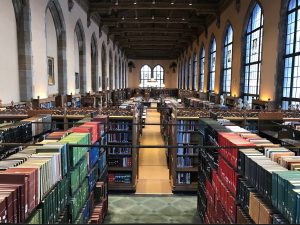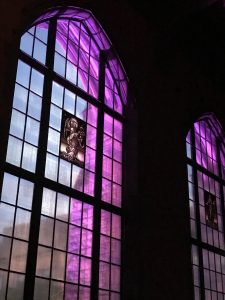
It’s National Archives Month! But you knew that, right? Chicago Collections and the Chicago Area Archivists have adopted the theme of “Hidden Stories” for Archives Month 2017, so we thought it would be appropriate to publish a series of blog entries highlighting the Libraries’ very own array of Distinctive Collections units. For those who have never had a chance to tour or collaborate with these units, we offer a behind-the-scenes look at each of the mysterious entities whose treasures are hidden in plain sight.
 Sure, it looks like a big room filled with a lot of books.
Sure, it looks like a big room filled with a lot of books.
But hidden beneath that veneer of silence lies the fast-paced, slam-bang, life-on-the-razor’s-edge, laugh-in-the-face-of-death world of academic art librarianship.
Perhaps surprisingly, there’s at least a measure of truth to both statements. The Art Collection’s space within Deering is a large, imposing room, with over a mile of books. But it is far from random assemblage of monographs, catalogs and art journals. Even before its designation as one of Northwestern Libraries’ Distinctive Collections, Art was a carefully curated subset of the library, a group of managed resources related to a common theme and responding to trends in art historical scholarship. Now, that curation continues apace, as we respond to the prevailing increase in available information. While “slam-bang” may be hyperbolic, the Art Library is not a static collection but a dynamic resource that demands constant attention.
The Art Library adds several thousand titles each year, each chosen to support the academic needs of both the faculty and student body. We respond to current faculty research requirements as well as to the course-specific demands at both the graduate and undergraduate levels. That necessitates a constant awareness of publishing schedules and specialties so that our overriding goal of (art) information access can be realized. We are committed to satisfying art historical needs across disciplines and across campus.
On a more practical level, the Art Collection needs to remain a usable resource. Those thousands of books don’t come with the space necessary to display them, and the library isn’t getting any larger. It is a constant balancing act between contemporary and historical scholarship, between what users need at the moment and what they might need in the future, between what should be on the shelf and what can be stored for retrieval. Like much scholarship in the humanities, current research is indebted to past, and the Art Library continually fine tunes its collection so that it contains both voices in proper measure.
It only looks like a big room full of books.
